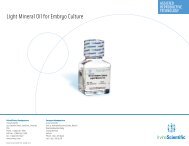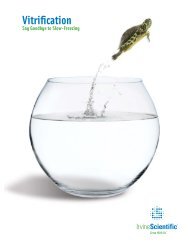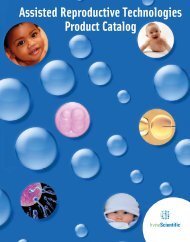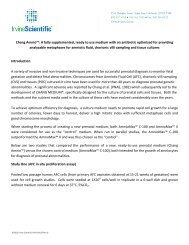Article Comparison of open and closed methods for ... - Irvine Scientific
Article Comparison of open and closed methods for ... - Irvine Scientific
Article Comparison of open and closed methods for ... - Irvine Scientific
Create successful ePaper yourself
Turn your PDF publications into a flip-book with our unique Google optimized e-Paper software.
<strong>Article</strong> - Vitrification <strong>of</strong> human embryos - M Kuwayama et al.<br />
<strong>of</strong> healthy births (El-Danasouri <strong>and</strong> Selman, 2001; Yokota<br />
et al., 2001a,b; V<strong>and</strong>erzwalmen et al., 2002; Mukaida et al.,<br />
2003; Kuwayama et al., 2005). The extensive reports to date<br />
exhibit ongoing improvements in vitrification <strong>methods</strong>, <strong>and</strong><br />
further support the overall efficacy <strong>of</strong> vitrification as a viable<br />
alternative to cryopreservation by slow cooling <strong>methods</strong>. The<br />
comprehensive results provided in this report further extend the<br />
efficacy <strong>and</strong> safety <strong>of</strong> vitrification <strong>for</strong> clinical human use.<br />
However, one <strong>of</strong> the major unresolved issues associated with<br />
the vitrification process is the choice <strong>of</strong> vessel, vial or straw<br />
to hold the embryo during vitrification. As overviewed in the<br />
Introduction, numerous types <strong>of</strong> vessels have been described<br />
in the literature. While all <strong>of</strong> these devices have been shown to<br />
work as carriers <strong>for</strong> embryos during vitrification, a number <strong>of</strong><br />
concerns have been raised regarding the potential risk to human<br />
embryos from exposure to contaminants already present in liquid<br />
nitrogen at the time <strong>of</strong> vitrification, or potentially introduced<br />
to the embryos during storage in <strong>open</strong> containers. While no<br />
studies have demonstrated unintentional uptake by a human<br />
or mammalian embryo <strong>of</strong> any pathogen during vitrification<br />
or storage, under experimental conditions such contamination<br />
may occur (Bielanski et al., 2000). Accordingly, a number <strong>of</strong><br />
governing bodies worldwide have expressed concern about<br />
the potential risk. Previous attempts to eliminate this danger<br />
included cooling per<strong>for</strong>med in liquid nitrogen filtered through<br />
a 0.2 μm pore-size filter <strong>and</strong> placing the carrier tool into a<br />
container that partially or completely isolates it from the liquid<br />
nitrogen during storage (Vajta et al., 1998; Kuwayama et al.,<br />
2005).<br />
As proven by the present work, the newly developed CryoTip<br />
method may provide a simple <strong>and</strong> practical solution to the<br />
problem. After loading, the plastic straw can be heat-sealed on<br />
both ends, <strong>and</strong> consequently the solution containing the embryo<br />
<strong>and</strong> the liquid nitrogen is hermetical isolated during cooling<br />
<strong>and</strong> storage. On the other h<strong>and</strong>, although the isolation slightly<br />
decreased the rate <strong>of</strong> cooling, the values that could be obtained<br />
with the CryoTip were still high enough to obtain appropriate<br />
vitrification. Consequently, embryo survival, as well as in-vitro<br />
<strong>and</strong> in-vivo developmental data, was identical to those achieved<br />
by the <strong>open</strong> Cryotop vitrification system. An additional benefit<br />
<strong>of</strong> the CryoTip vitrification is that any embryologist familiar<br />
with the usual method <strong>of</strong> loading <strong>and</strong> sealing 0.25 ml cryostraws<br />
will easily accommodate to using the smaller volume,<br />
but similar approach in h<strong>and</strong>ling, <strong>of</strong> the CryoTip. Moreover, the<br />
protective metal sleeve ensures safe storage <strong>of</strong> the CryoTip in<br />
a relatively small space, <strong>and</strong> the sleeve as well as the wide part<br />
<strong>of</strong> the plastic tube <strong>of</strong>fers enough space <strong>for</strong> proper marking <strong>of</strong><br />
straws <strong>for</strong> safe identification.<br />
Recently, Isachenko et al. (2005) published a method <strong>for</strong> aseptic<br />
vitrification <strong>of</strong> human zygotes by using <strong>open</strong> pulled straws<br />
(Vajta et al., 1998) hermetically isolated from liquid nitrogen<br />
be<strong>for</strong>e cooling. According to the authors, the considerably<br />
decreased cooling rate achievable by this technique did<br />
not compromise survival <strong>and</strong> further development. This<br />
observation is in contrast to unpublished observations, <strong>and</strong><br />
seems to contradict the principles <strong>of</strong> many previous ultrarapid<br />
vitrification <strong>methods</strong> (Martino et al., 1996; Vajta et al., 1998;<br />
Lane et al., 1999; Park et al., 2000; V<strong>and</strong>erzwalmen et al., 2000;<br />
Liebermann <strong>and</strong> Tucker, 2002; Katayama et al., 2003; Mukaida<br />
et al., 2003; Kuwayama et al., 2005). Moreover, it may also<br />
be questioned if the physical phenomenon <strong>of</strong> vitrification could<br />
be obtained by using the applied cryoprotectant concentrations<br />
<strong>and</strong> the achievable cooling rate in the method <strong>of</strong> Isachenko<br />
et al. (2005). Based on these concerns, further comparative<br />
investigations per<strong>for</strong>med by independent groups might be<br />
required to determine the difference in efficiency <strong>and</strong> practical<br />
value <strong>of</strong> the two approaches.<br />
In conclusion, the present results, based on more than 16,000<br />
human embryo cryopreservations, prove that vitrification is<br />
a simple, inexpensive <strong>and</strong> safe alternative <strong>of</strong> traditional slow<br />
cooing resulting in higher survival <strong>and</strong> in-vitro developmental<br />
rates <strong>for</strong> PN, multicellular <strong>and</strong> blastocyst stage human embryos.<br />
Pregnancy <strong>and</strong> live birth dates did not differ between the<br />
two <strong>methods</strong>. Additionally, the newly developed CryoTip TM<br />
technology eliminates the danger <strong>of</strong> contamination while<br />
maintaining the high efficiency <strong>of</strong> the procedure.<br />
References<br />
Anderson AR 2005 Reduction <strong>of</strong> high order multiples in frozen<br />
embryo transfers. Reproductive BioMedicine Online 10, 402–405.<br />
Bielanski A, Nadin-Davis S, Sapp T et al. 2000 Viral contamination<br />
<strong>of</strong> embryos cryopreserved in liquid nitrogen. Cryobiology 40,<br />
110–116.<br />
Chen SU, Lien YR, Chao KH et al. 2000 Cryopreservation <strong>of</strong> mature<br />
human oocytes by vitrification with ethylene glycol in straws.<br />
Fertility <strong>and</strong> Sterility 74, 804–808.<br />
Cremades N, Sousa M, Silva J et al. 2004 Experimental vitrification<br />
<strong>of</strong> human compacted morulae <strong>and</strong> early blastocysts using fine<br />
diameter plastic micropipettes. Human Reproduction 19, 300–305.<br />
El-Danasouri I, Selman H 2001 Successful pregnancies <strong>and</strong> deliveries<br />
after a simple vitrification protocol <strong>for</strong> day 3 human embryos.<br />
Fertility <strong>and</strong> Sterility 76, 400–402.<br />
Fuller B, Paynter S, 2004 Fundamentals <strong>of</strong> cryobiology in<br />
reproductive medicine. Reproductive BioMedicine Online 9,<br />
680–691.<br />
Huang CC, Lee TH, Chen SU et al. 2004 Successful pregnancy<br />
following blastocyst cryopreservation using super-cooling ultrarapid<br />
vitrification. Human Reproduction 20, 122–128.<br />
Isachenko V, Montag M, Isachenko E et al. 2005 Aseptic technology<br />
<strong>of</strong> vitrification <strong>of</strong> human pronuclear oocytes using <strong>open</strong>-pulled<br />
straws. Human Reproduction 20, 492–496.<br />
Isachenko V, Montag M, Isachenko E et al. 2004a Developmental rate<br />
<strong>and</strong> ultrastructure <strong>of</strong> vitrified human pronuclear oocytes after stepwise<br />
versus direct rehydration. Human Reproduction 19, 660–665.<br />
Isachenko V, Selman H, Isachenko E et al. 2004b Effect <strong>of</strong><br />
cryoprotectants on the ultrastructure <strong>of</strong> cooled human pronuclear<br />
oocytes. Fertility <strong>and</strong> Sterility 81, 720–722.<br />
Isachenko V, Selman H, Isachenko E et al. 2003 Modified vitrification<br />
<strong>of</strong> human pronuclear oocytes: efficacy <strong>and</strong> effect on ultrastructure.<br />
Reproductive BioMedicine Online 7, 211–216.<br />
Jelinkova L, Selman H, Arav A et al. 2002 Twin pregnancy after<br />
vitrification <strong>of</strong> 2-pronuclei human embryos. Fertility <strong>and</strong> Sterility<br />
77, 412–414.<br />
Kasai M 2004 Cryopreservation <strong>of</strong> animal <strong>and</strong> human embryos by<br />
vitrification. Reproductive BioMedicine Online 9, 164–170.<br />
Katayama KP, Stehlik J, Kuwayama M et al. 2003 High survival rate<br />
<strong>of</strong> vitrified human oocytes results in clinical pregnancy. Fertility<br />
<strong>and</strong> Sterility 80, 223–224.<br />
Kuleshova LL, Lopata A 2002 Vitrification can be more favorable than<br />
slow cooling. Fertility <strong>and</strong> Sterility 78, 449–454.<br />
Kuleshova LL, Shaw JM 2000 A strategy <strong>for</strong> rapid cooling <strong>of</strong><br />
mouse embryos within a double straw to eliminate the risk<br />
<strong>of</strong> contamination during storage in liquid nitrogen. Human<br />
Reproduction 15, 2604–2609.<br />
Kuwayama M, Vajta G, Kato L, Leibo SP Highly efficient vitrification<br />
method <strong>for</strong> cryopreservation <strong>of</strong> human oocytes. Reproductive<br />
613
















